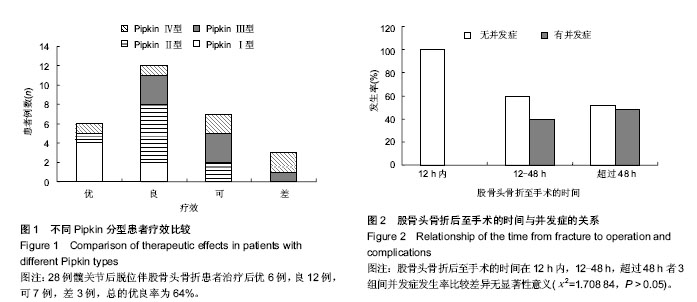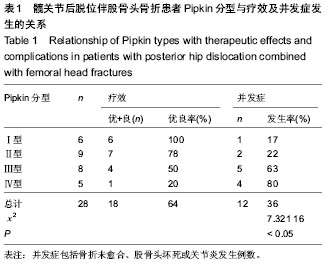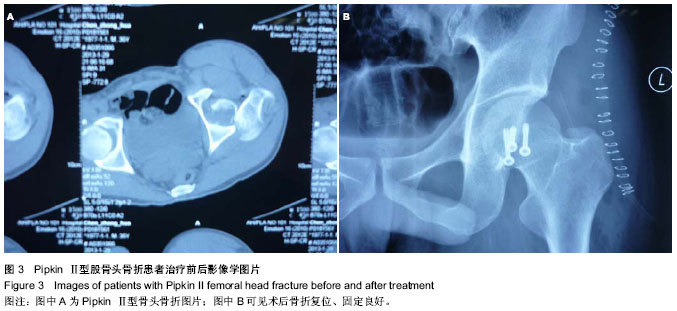| [1] 卢世壁,王岩.坎贝尔骨科手术学[M].10版.山东科学技术出版社, 2003:2810-2811.[2] 胥少汀,葛宝丰,徐印坎. 实用骨科学[M].3版.北京:人民军医出版社,2008:708.[3] Schmidt GL, Sciulli R, Altman GT.Knee injury in patients experiencing a high-energy traumatic ipsilateral hip dislocation.J Bone Joint Surg Am. 2005;87(6):1200-1204.[4] Brumback RJ, Kenzora JE, Levitt LE,et al.Fractures of the femoral head.Hip. 1987:181-206.[5] Zehi K, Karray S, Litaiem T,et al.Fracture-luxation of the femur head. Apropos of 10 cases.Acta Orthop Belg. 1997;63(4): 268-273.[6] Thompson VP ,Epstein HC.Traumatic dislocation of the hip; a survey of two hundred and four cases covering a period of twenty-one years.J Bone Joint Surg Am. 1951;33-A(3): 746-478.[7] Stewart MJ, Miflord LW.Fracture-dislocation of the hip; an end-result study.J Bone Joint Surg Am. 1954;36(A:2):315- 342.[8] Pipkin G.Treatment of grade IV fracture-dislocation of the hip.J Bone Joint Surg Am. 1957;39-A(5):1027-1042.[9] Hougaard K, Thomsen PB.Traumatic posterior fracture-dislocation of the hip with fracture of the femoral head or neck, or both.J Bone Joint Surg Am. 1988;70(2):233-239.[10] Tripathy SK, Sen RK, Goyal T.Conservative versus surgical management of Pipkin type I fractures associated with posterior dislocation of the hip: a randomised controlled trial.Int Orthop. 2011;35(12):1907-1908[11] Thannheimer A, Gutsfeld P, Bühren V.Current therapy options for fractures of the femoral head.Chirurg. 2009;80(12):1140- 1146.[12] Stannard JP, Harris HW, Volgas DA,et al.Functional outcome of patients with femoral head fractures associated with hip dislocations.Clin Orthop Relat Res. 2000;(377):44-56.[13] 张涛,马宝通,庞贵根,等. Pipkin骨折分型的临床研究[J].中华创伤杂志,2011,27(7):608-613.[14] 蔡贤华,陈庄洪,徐永年,等.不同髋臼骨折手术入路选择的相关性因素分析[J] .中国矫形外科杂志, 2006, 14(20): 1526-1528.[15] 高曙光,雷光华,李康华,等. 后侧入路可吸收螺钉内固定治疗股骨头骨折[J] .医学临床研究,2007,24(2):322-324.[16] 梁笃,杨冰,郑永华,等. Kocher-Langenbeck入路治疗髋臼后壁骨折合并股骨头骨折[J].中医正骨,2013,25(6):38-39,41.[17] Jessberger S, Blattert TR, Wagner R,et al.Reducing approach-associated morbidity in fracture dislocation of the femoral head--a longitudinal study (1982-2000).Zentralbl Chir. 2002;127(6):485-489.[18] Tannast M, Siebenrock KA.Operative treatment of T-type fractures of the acetabulum via surgical hip dislocation or Stoppa approach.Oper Orthop Traumatol. 2009;21(3): 251-269.[19] 郭涛,肖冬生,董华. 髋关节后脱位并股骨头骨折治疗体会[J].当代医学,2009,15(18):95-96.[20] 倪宏伟,李正维,周伟,等.采用前路切口治疗Pipkin Ⅰ、Ⅱ型股骨头骨折[J].中国矫形外科杂志 ,2007,15(10):786-787.[21] 高苏宁,赵红军,苏明海,等.股骨头骨折的手术治疗探讨[J].实用骨科杂志,2006,12(2):116-117.[22] Lang-Stevenson A, Getty CJ.The Pipkin fracture-dislocation of the hip.Injury. 1987;18(4):264-269.[23] Mat?jka J, Koudela K.Bilateral fractures of the femoral head (Pipkin I and Pipkin II).Acta Chir Orthop Traumatol Cech. 2002;69(6):369-371.[24] Tonetti J, Ruatti S, Lafontan V, et al.Is femoral head fracture-dislocation management improvable: A retrospective study in 110 cases.Orthop Traumatol Surg Res. 2010; 96(6): 623-631.[25] Gö?ü? A, Akpinar S, Unal M, et al.Hip fracture-dislocation (Pipkin type IV) associated with an apparent traumatic aortic valve rupture. Case history.Ulus Travma Derg. 2001;7(1): 66-69. [26] 甄平,李旭升,田琦,等.一期全髋关节置换术治疗Pipkin Ⅳ型骨折合并股骨转子间骨折[J].中华创伤骨科杂志,2012,14(8):689- 692.[27] 刘伟乐,易瑜华,孙春汉. Pipkin骨折手术治疗体会[J].河南外科学杂志,2013,19(3):86.[28] 李淳德,马忠泰,吴常德,等.可吸收螺钉及固定棒(SR-PGA,PLLA)临床应用的初步报告[J].中华骨科杂志,2009,15(11):755-757.[29] 黄相杰,周志高,姜红江等.国产可吸收钉在治疗髋部骨折中的应用[J].骨与关节损伤杂志,2004,19(2):93. [30] 姜保国,张殿英,付中国.股骨近端骨折的治疗[J].中华创伤骨科杂志,2004,6(5):484-487.[31] Marchetti ME, Steinberg GG, Coumas JM.Intermediate-term experience of Pipkin fracture-dislocations of the hip.J Orthop Trauma. 1996;10(7):455-461.[32] Henle P, Kloen P, Siebenrock KA.Femoral head injuries: Which treatment strategy can be recommended?Injury. 2007; 38(4):478-488.[33] 陈志文,丁真奇,林斌,等.骨块切除术治疗PipkinⅠ型股骨头骨折[J].实用骨科杂志,2011,17(10):928-930.[34] 王仁,齐东海,许向东,等.切开复位可吸收螺钉和重建钢板内固定治疗Pipkin Ⅳ型骨折[J].中华创伤骨科杂志,2013,15(8):722- 723.[35] 刘欣伟,苏佳灿,张春才. Pipkin骨折临床治疗18例分析[J].创伤外科杂志,2008,10(3):241-243 |


